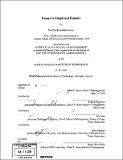Essays in empirical finance
Author(s)
Kumar, Pavithra Kamakshi
DownloadFull printable version (11.41Mb)
Other Contributors
Sloan School of Management.
Advisor
Roberto Rigobon, Jun Qian and Alex Edmans.
Terms of use
Metadata
Show full item recordAbstract
The first chapter in my thesis investigates the association between selected hedge fund characteristics and persistence in performance over time. Analyzing TASS data from 1996-2006, I observe a positive correlation between persistence in good performance and fund size, as well as age. Furthermore, I find that more illiquid investment strategies exhibit significantly stronger persistence in good performance, both in the short and long run, even after controlling for illiquidity risk. These results indicate that higher fund size, age, and exposure to illiquidity are reflective of superior managerial skill. Finally, I note that funds with higher incentive fees display greater persistence in both good and bad (post-fee) performance in the long run. These findings are consistent with a scenario in which incentive fees are raised by both skilled and unskilled, (but lucky), fund managers in response to good past performance. Therefore, my analysis suggests that incentive fees for hedge funds may be endogenously determined. The second chapter tests a simple explanation for momentum profits: systematic out performance arises because certain stocks have persistently strong fundamentals which are not fully valued by the market. We find that "winner" portfolios have higher book-to-market ratios than "loser" portfolios, and the economic and statistical significance of momentum profits is markedly reduced when calculated above value benchmarks. A large component of the returns to relative strength portfolios may thus stem from such portfolios overweighting high value stocks, suggesting a close relation between the value and momentum anomalies. The final chapter develops a measure of international financial contagion using a semi structural approach. (cont.) In particular, we work with a multi-country dynamic equilibrium setting, placing a constraint on portfolio volatility. The tightening of this constraint is a channel through which shocks are propagated globally in our model. We then derive a measure of the tightness of the constraint, or 'contagion', using cross-equation restrictions. We finally evaluate our measure of international contagion with regards to its predictability on global asset price co-movement, as well as on news about the recent sub-prime crisis. We find evidence that our contagion estimator is a strong measure of the sub-prime crisis in this regard.
Description
Thesis (Ph. D.)--Massachusetts Institute of Technology, Sloan School of Management, 2008. Includes bibliographical references.
Date issued
2008Department
Sloan School of ManagementPublisher
Massachusetts Institute of Technology
Keywords
Sloan School of Management.